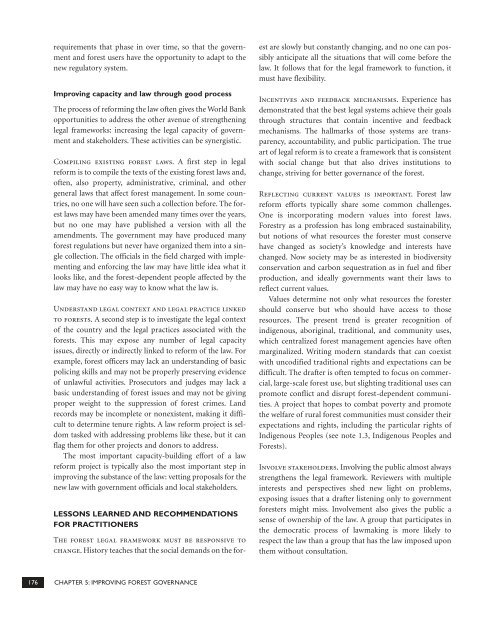Forests Sourcebook - HCV Resource Network
Forests Sourcebook - HCV Resource Network
Forests Sourcebook - HCV Resource Network
You also want an ePaper? Increase the reach of your titles
YUMPU automatically turns print PDFs into web optimized ePapers that Google loves.
equirements that phase in over time, so that the government<br />
and forest users have the opportunity to adapt to the<br />
new regulatory system.<br />
Improving capacity and law through good process<br />
The process of reforming the law often gives the World Bank<br />
opportunities to address the other avenue of strengthening<br />
legal frameworks: increasing the legal capacity of government<br />
and stakeholders. These activities can be synergistic.<br />
Compiling existing forest laws. A first step in legal<br />
reform is to compile the texts of the existing forest laws and,<br />
often, also property, administrative, criminal, and other<br />
general laws that affect forest management. In some countries,<br />
no one will have seen such a collection before. The forest<br />
laws may have been amended many times over the years,<br />
but no one may have published a version with all the<br />
amendments. The government may have produced many<br />
forest regulations but never have organized them into a single<br />
collection. The officials in the field charged with implementing<br />
and enforcing the law may have little idea what it<br />
looks like, and the forest-dependent people affected by the<br />
law may have no easy way to know what the law is.<br />
Understand legal context and legal practice linked<br />
to forests. A second step is to investigate the legal context<br />
of the country and the legal practices associated with the<br />
forests. This may expose any number of legal capacity<br />
issues, directly or indirectly linked to reform of the law. For<br />
example, forest officers may lack an understanding of basic<br />
policing skills and may not be properly preserving evidence<br />
of unlawful activities. Prosecutors and judges may lack a<br />
basic understanding of forest issues and may not be giving<br />
proper weight to the suppression of forest crimes. Land<br />
records may be incomplete or nonexistent, making it difficult<br />
to determine tenure rights. A law reform project is seldom<br />
tasked with addressing problems like these, but it can<br />
flag them for other projects and donors to address.<br />
The most important capacity-building effort of a law<br />
reform project is typically also the most important step in<br />
improving the substance of the law: vetting proposals for the<br />
new law with government officials and local stakeholders.<br />
LESSONS LEARNED AND RECOMMENDATIONS<br />
FOR PRACTITIONERS<br />
The forest legal framework must be responsive to<br />
change. History teaches that the social demands on the forest<br />
are slowly but constantly changing, and no one can possibly<br />
anticipate all the situations that will come before the<br />
law. It follows that for the legal framework to function, it<br />
must have flexibility.<br />
Incentives and feedback mechanisms. Experience has<br />
demonstrated that the best legal systems achieve their goals<br />
through structures that contain incentive and feedback<br />
mechanisms. The hallmarks of those systems are transparency,<br />
accountability, and public participation. The true<br />
art of legal reform is to create a framework that is consistent<br />
with social change but that also drives institutions to<br />
change, striving for better governance of the forest.<br />
Reflecting current values is important. Forest law<br />
reform efforts typically share some common challenges.<br />
One is incorporating modern values into forest laws.<br />
Forestry as a profession has long embraced sustainability,<br />
but notions of what resources the forester must conserve<br />
have changed as society’s knowledge and interests have<br />
changed. Now society may be as interested in biodiversity<br />
conservation and carbon sequestration as in fuel and fiber<br />
production, and ideally governments want their laws to<br />
reflect current values.<br />
Values determine not only what resources the forester<br />
should conserve but who should have access to those<br />
resources. The present trend is greater recognition of<br />
indigenous, aboriginal, traditional, and community uses,<br />
which centralized forest management agencies have often<br />
marginalized. Writing modern standards that can coexist<br />
with uncodified traditional rights and expectations can be<br />
difficult. The drafter is often tempted to focus on commercial,<br />
large-scale forest use, but slighting traditional uses can<br />
promote conflict and disrupt forest-dependent communities.<br />
A project that hopes to combat poverty and promote<br />
the welfare of rural forest communities must consider their<br />
expectations and rights, including the particular rights of<br />
Indigenous Peoples (see note 1.3, Indigenous Peoples and<br />
<strong>Forests</strong>).<br />
Involve stakeholders. Involving the public almost always<br />
strengthens the legal framework. Reviewers with multiple<br />
interests and perspectives shed new light on problems,<br />
exposing issues that a drafter listening only to government<br />
foresters might miss. Involvement also gives the public a<br />
sense of ownership of the law. A group that participates in<br />
the democratic process of lawmaking is more likely to<br />
respect the law than a group that has the law imposed upon<br />
them without consultation.<br />
176 CHAPTER 5: IMPROVING FOREST GOVERNANCE

















